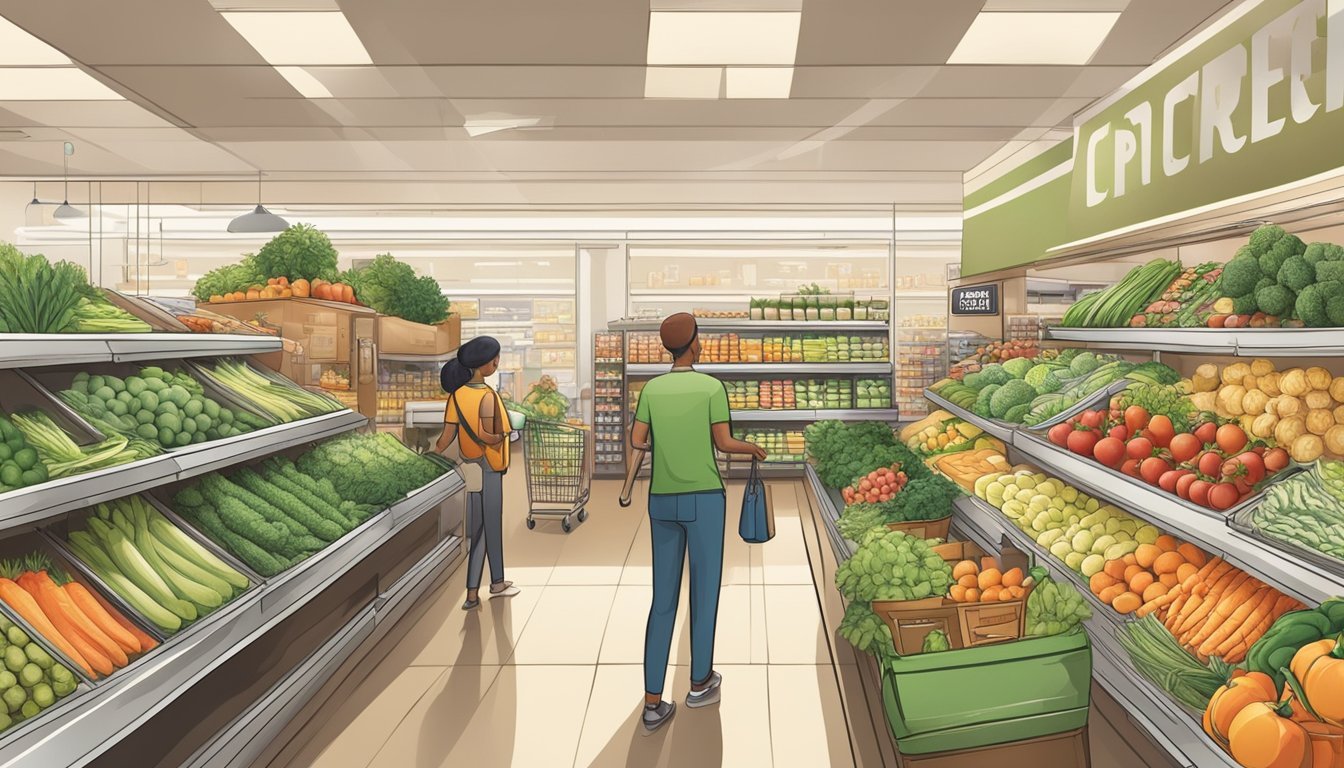Grocery Outlet vs Whole Foods
A Comprehensive Price and Quality Comparison
Grocery shopping can be a balancing act between finding quality products and managing a budget. Two popular grocery chains, Grocery Outlet and Whole Foods, represent different ends of the spectrum when it comes to price and product selection.
Grocery Outlet typically offers lower prices overall, while Whole Foods focuses on premium, organic options at higher price points. This fundamental difference shapes the shopping experience at each store and appeals to different consumer priorities.
The choice between Grocery Outlet and Whole Foods often depends on individual preferences, dietary needs, and financial considerations. Grocery Outlet attracts bargain hunters with its discounted brand-name products, while Whole Foods caters to health-conscious shoppers seeking organic and specialty items.
Overview of Grocery Outlet and Whole Foods
Grocery Outlet and Whole Foods represent two distinct approaches to grocery retail in the United States. These chains cater to different consumer segments with unique business models and philosophies.
History and Business Models
Grocery Outlet originated in 1946 as a surplus food distributor. The company operates on an "extreme value" model, selling discounted surplus and overstock items from national brands. Grocery Outlet uses a franchise system, with independently operated stores.
Whole Foods Market began in 1980 in Austin, Texas. It focuses on natural and organic products, emphasizing high-quality, sustainably sourced items. In 2017, Amazon acquired Whole Foods, bringing e-commerce capabilities and Prime member benefits to the chain.
Geographical Presence
Grocery Outlet has expanded from its West Coast roots to over 400 locations across the United States. In 2011, the company began its East Coast expansion, marking significant growth.
Whole Foods boasts over 500 stores across North America and the United Kingdom. Its strongholds remain in urban and suburban areas, particularly those with health-conscious populations.
Target Customer Base
Grocery Outlet appeals to budget-conscious shoppers seeking discounts on brand-name products. The store attracts customers who enjoy "treasure hunt" shopping experiences, as inventory changes frequently based on available surplus.
Whole Foods targets health-conscious consumers willing to pay premium prices for organic and natural products. The chain also appeals to ethical shoppers concerned with sustainability and fair trade practices.
Brand Philosophy and Public Perception
Grocery Outlet's philosophy centers on providing significant savings to customers. The company prides itself on offering up to 70% off conventional retail prices. Public perception views Grocery Outlet as a quirky, no-frills option for bargain hunters.
Whole Foods maintains a reputation for quality and ethical standards. The brand emphasizes environmental stewardship and community engagement. However, its "Whole Paycheck" nickname reflects a perception of high prices, despite efforts to offer more affordable options.
Product Range and Quality
Grocery Outlet and Whole Foods offer distinct product selections tailored to different customer needs and preferences. Their offerings vary in terms of variety, quality, and pricing across key grocery categories.
Fresh Produce and Organic Offerings
Whole Foods excels in organic and locally-sourced produce. They stock a wide array of fruits and vegetables, including rare and seasonal items. The quality is consistently high, with vibrant colors and fresh textures.
Grocery Outlet's produce section is more limited but offers good value. While organic options are available, the selection is smaller than Whole Foods. Produce quality can vary, but many items are perfectly good despite being close to their sell-by date.
Both stores prioritize sustainability, but Whole Foods has stricter sourcing standards and a more extensive organic range.
Meat and Seafood Selection
Whole Foods provides an impressive array of high-quality meats and seafood. Their butcher counters offer prime cuts, grass-fed beef, and specialty items like dry-aged steaks. The seafood department features sustainably sourced options and knowledgeable staff.
Grocery Outlet's meat and seafood selections are more basic. Pre-packaged meats are common, with fewer specialty cuts available. Seafood options are limited but can include good deals on frozen items.
Quality standards differ, with Whole Foods maintaining stricter animal welfare and sourcing policies.
Dairy and Bakery Departments
Whole Foods boasts an extensive dairy section with organic, plant-based, and artisanal options. Their in-store bakery produces fresh bread, pastries, and cakes daily. Specialty cheeses and non-dairy alternatives are plentiful.
Grocery Outlet's dairy selection focuses on mainstream brands at discounted prices. Their bakery offerings are more limited, often featuring pre-packaged items rather than fresh-baked goods. Cheese options tend to be more basic but can include unexpected specialty finds.
Both stores carry lactose-free and vegan alternatives, but Whole Foods offers a broader range.
Packaged Foods and Private Labels
Whole Foods' 365 brand covers a wide range of products, emphasizing natural ingredients and organic options. They stock numerous specialty diet items (gluten-free, paleo, keto) and international foods.
Grocery Outlet carries a rotating inventory of name-brand packaged goods at discounted prices. Their selection can be unpredictable but often includes popular brands. Private label options are more limited compared to Whole Foods.
Both stores offer unique finds, but Grocery Outlet's inventory changes more frequently, encouraging a "treasure hunt" shopping experience. Whole Foods provides a more consistent, curated selection of natural and organic packaged foods.
Pricing Strategies and Affordability
Grocery Outlet and Whole Foods employ distinct pricing strategies that cater to different consumer segments. Their approaches to affordability reflect their brand positioning and target markets.
Regular Prices and Discount Policies
Grocery Outlet focuses on offering deeply discounted products. They purchase excess inventory and closeout items from manufacturers, passing savings on to customers. Prices can be 40-70% lower than conventional supermarkets. Their inventory changes frequently based on available deals.
Whole Foods maintains higher regular prices, reflecting their focus on premium, organic, and specialty products. They run weekly sales and promotions to provide some savings opportunities. Since Amazon's acquisition, Whole Foods has made efforts to lower prices on staple items to improve affordability perceptions.
Deals for Members and Loyalty Programs
Grocery Outlet does not offer a formal loyalty program. Their business model relies on consistently low prices rather than member-exclusive deals.
Whole Foods provides additional discounts for Amazon Prime members. Benefits include:
10% off sale items
Exclusive weekly deals
Free delivery on orders over $35
This integration with Amazon Prime aims to drive customer loyalty and increase shopping frequency.
Comparison with Other Retailers
Grocery Outlet's prices are often lower than major chains like Walmart and Target on comparable items. However, selection can be limited and inconsistent.
Whole Foods prices remain higher than most conventional supermarkets, even after recent efforts to improve affordability. Their organic produce and specialty items are often priced similarly to or slightly above competitors like Trader Joe's.
Walmart and Target generally offer lower prices than Whole Foods on national brands and basic groceries. However, Whole Foods' private label "365" line is competitively priced for organic options.
Warehouse clubs like Costco can offer better bulk pricing on some items compared to both Grocery Outlet and Whole Foods, but require membership fees.
Shopping Experience and Amenities
Grocery Outlet and Whole Foods offer distinct shopping experiences with varying amenities. Their approaches to store design, customer service, prepared foods, and online options reflect different priorities and target customers.
Store Layout and Design
Grocery Outlet stores typically feature a no-frills layout focused on efficiency and value. Aisles are often arranged simply, with products displayed in their original shipping boxes to reduce costs. The stores emphasize bargain-hunting, with prominently displayed discounts and deals.
Whole Foods, in contrast, designs its stores to create an upscale, market-like atmosphere. The layout often includes spacious produce sections, artisanal cheese counters, and dedicated areas for organic and specialty items. Lighting and decor are carefully chosen to enhance the shopping experience.
Customer Service and Support
Grocery Outlet stores generally operate with a lean staff model. Employees are available to assist customers, but the focus is on self-service and efficiency. Checkout lines are typically short due to the smaller store sizes and customer base.
Whole Foods invests heavily in customer service. Knowledgeable staff members are often stationed throughout the store to offer product recommendations and answer questions. Many locations feature dedicated customer service desks for returns, special orders, and inquiries.
Prepared Food and In-Store Dining
Grocery Outlet's prepared food offerings are limited. Some stores may have a small deli section with basic sandwiches and salads, but in-store dining options are rare.
Whole Foods excels in this area, offering extensive prepared food sections. Many stores feature hot and cold food bars, made-to-order sandwiches, and pizza stations. Larger locations often include in-store cafes or seating areas for customers to enjoy their purchases.
Online Ordering and Grocery Delivery Options
Grocery Outlet has limited online presence. Most locations do not offer online ordering or delivery services, focusing instead on in-store bargain shopping.
Whole Foods, backed by Amazon, provides robust online ordering and delivery options. Customers can shop through the Amazon website or app, with same-day delivery available in many areas. Amazon Prime members receive additional benefits, such as free delivery on qualifying orders.
Health and Sustainability
Grocery Outlet and Whole Foods differ significantly in their approaches to health and sustainability. These factors play a crucial role for many consumers when choosing where to shop.
Organic and Natural Food Options
Whole Foods excels in offering organic and natural products. The store stocks a wide variety of organic produce, meats, dairy, and packaged goods. Many items are locally sourced and clearly labeled. Whole Foods also carries numerous specialty health foods like gluten-free, vegan, and non-GMO options.
Grocery Outlet's organic selection is more limited. While they do offer some organic produce and natural products, the availability can be inconsistent. Their focus is on providing discounted prices rather than extensive organic options. Health-conscious buyers may find Grocery Outlet's selection lacking compared to Whole Foods.
Efforts Towards Sustainability
Whole Foods has made sustainability a core part of its brand identity. The company has implemented numerous eco-friendly practices:
Eliminating plastic bags at checkout
Using renewable energy in stores
Offering electric vehicle charging stations
Implementing composting and recycling programs
Grocery Outlet's sustainability efforts are less prominent. While they do focus on reducing food waste through their discount model, their overall sustainability initiatives are not as comprehensive as Whole Foods. The company has made some strides in energy efficiency but lacks the same level of visible commitment to environmental causes.
Market Position and Future Outlook
Grocery Outlet and Whole Foods occupy distinct positions in the grocery retail landscape. Each company employs unique strategies to maintain competitiveness and drive growth in an evolving market.
Competitive Analysis
Grocery Outlet's extreme value model sets it apart from traditional grocers. The company offers discounts of 40% to 70% on name-brand products, appealing to budget-conscious shoppers. This approach has fueled steady growth, with Grocery Outlet reporting a 6.3% year-over-year sales increase in Q4 2023.
Whole Foods, owned by Amazon, targets health-conscious consumers with its focus on organic and natural products. The integration with Amazon's ecosystem provides advantages in e-commerce and delivery services.
Wegmans and Market Basket pose competition in regional markets, known for their customer service and competitive pricing respectively.
Innovation and Growth Strategies
Grocery Outlet plans to open 15 to 20 new stores in 2024, aiming for net sales of $4.3 billion to $4.35 billion. The company's flexible buying model allows it to adapt quickly to changing consumer demands and market conditions.
Whole Foods leverages technology to enhance the shopping experience. The company has implemented cashier-less checkout systems and personalized recommendations through the Amazon Prime program.
Both retailers are investing in data analytics and automation to optimize operations and improve efficiency. These innovations aim to create agile businesses capable of responding to granular shifts in consumer preferences.






